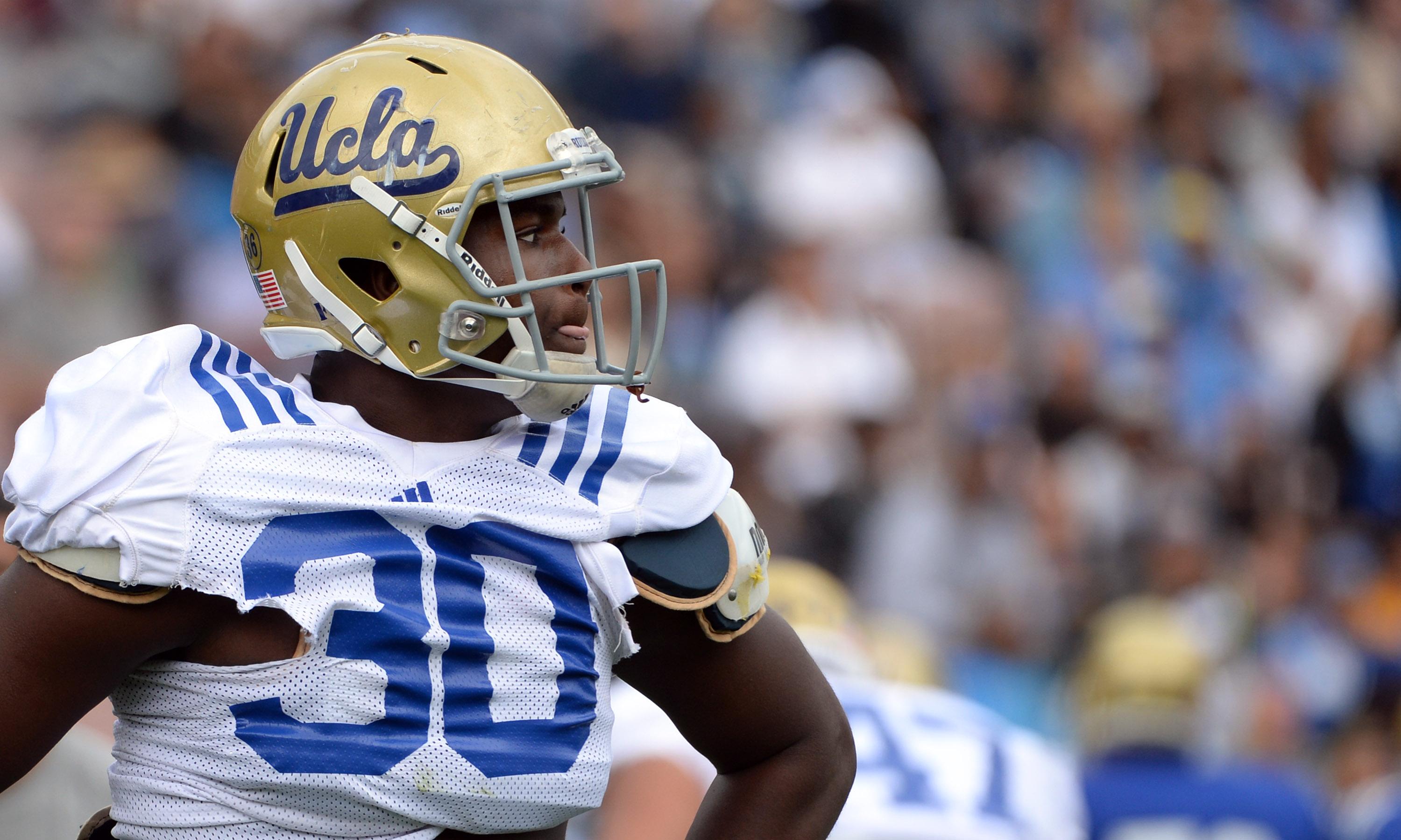
UCLA linebacker Myles Jack is out four to six months after undergoing surgery to repair an anterior meniscus tear. (Keith Birmingham/Staff)
UCLA linebacker Myles Jack tore his anterior meniscus this week, and underwent knee surgery that head coach Jim Mora said will end his season. Jack is sidelined for the next four to six months rather than weeks, Mora explained, because he had his meniscus stitched — a process that requires more rehab.
Dr. Scott Rodeo is the co-chief emeritus of sports medicine and shoulder service at the Hospital for Special Surgery in New York, as well as the team physician for the New York Giants. He answered some questions about Jack’s injury, as well as the star linebacker’s prospective recovery timetable.
Q: What are the advantages of opting for a stitch over trimming the meniscus?
A: “It’s only a minority of tears that are repairable, based on the location of a tear, and blood supply to the meniscus. But if it’s a repairable tear, it’s better to repair for the long-term health of that knee. The issue is that it takes time to heal. Most of the time, (trimming) a torn meniscus, you can get back to sports in three to four weeks. It can be quick. In contrast, a repair, you let the meniscus heal, and it takes time. It’s a much different rehab, but better in the long term for the kid’s knee.”
Q: Is a four- to six-month recovery timetable a conservative estimate, or is that fairly common after a meniscus is stitched?
A: “That’s very typical. It may take more. It can take a knee up to six months, to really let it heal, and then get your motion back — your strength, coordination, balance, and everything in the knee. Four to six months is perfectly appropriate. It almost takes you back to contact sports. You can run between months three and four, and at the four-month point kind of progress to more sports-specific activity. Full-go contact can be at least six months there.”
Q: Do any effects linger from this type of injury?
A: “It can. It depends on a lot of factors. The biggest effect it’ll have on the knee in years to come would be other injuries. Particularly if there’s injury to the joint surface, the cartilage on the surface, that can affect the outcome in the next three to five years. If it’s just an isolated meniscus tear, if everything else is normal in the knee, you can expect it to heal quite well. Based on our data, kind of 85 to 90 percent good clinical outcomes in that setting. It’s not perfect but it’s pretty good.”
Q: How much does Myles Jack’s age help his chances at a recovery?
A: “It helps. Meniscus healing as far as the biology of healing, the younger patient versus your older patient. A 20-year-old, it’s probably good quality tissue that works in his favor. … Young patient with a good knee, you’d like to try to salvage and maintain your meniscus if you tear it. The only downside is it does take time.”
Q: Given Myles Jack’s position and the amount of lateral movement it demands, is it more crucial that he rests is properly before returning to the field?
“Yeah, definitely. Meniscus healing is even more dependent on just his ability to regain coordination, balance, strength. The return to sports can take longer. It might be strong and healed and six months, but he might not get back to sports can perform at a high level until more like 10 months. That’s more dependent on function. That’s coordination, balance, strength. The demands are relatively high in football. To put him back on the field, where he’s got adequate strength and balance and the ability to protect himself and play at a high level, it can be every bit of six months.”
Q: In your experience with these types of tears, what’s the best-case scenario in terms of recovery time?
“I’d see him trying to get back after the four-month point, but it’s probably not advisable. Part of it is, he may not have full function as far as the other factors I mentioned — strength, balance, coordination. The other part of it is, the meniscus itself needs to continue to heal and mature and remodel. That’s a gradual process. I would give it up to six months.
“It’s not a cookbook type of thing. It’s not just based on a calendar. Returning to sports is determined based on the athlete’s function. It’s not one size fits all. Some athletes are ready in four and a half months. Some take eight months. So it’s got to be individualized. He has to be able to assess how that individual is doing, put them through the functional tests, and really make sure that they’re ready and able to go back.”
Q: If Myles Jack declares for the NFL draft, could he be up to his pre-injury form in time for the NFL Combine in February and other pre-draft workouts?
“Five months from now, so he’ll be getting there. He may not be 100 percent, but he may be pretty close. I think teams will still want to assess his meniscus, but he should be pretty far along.”
